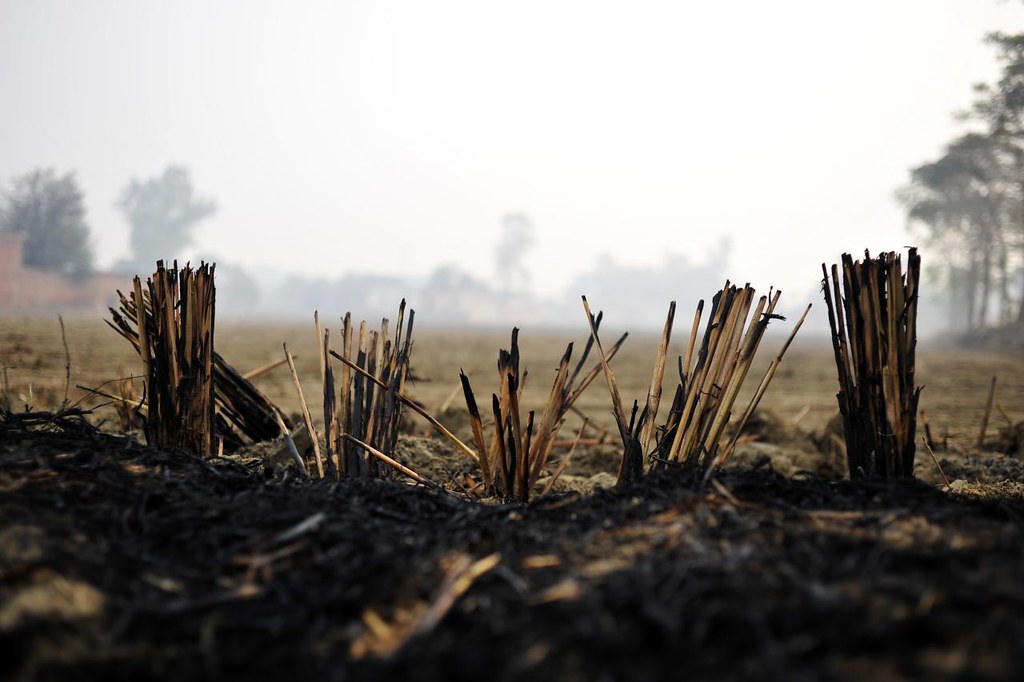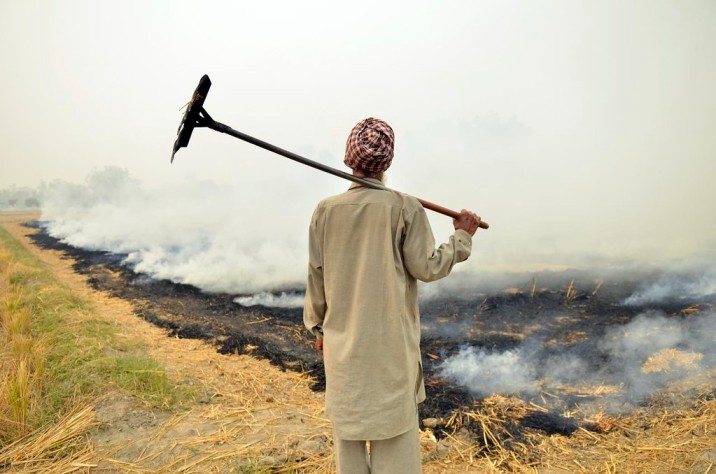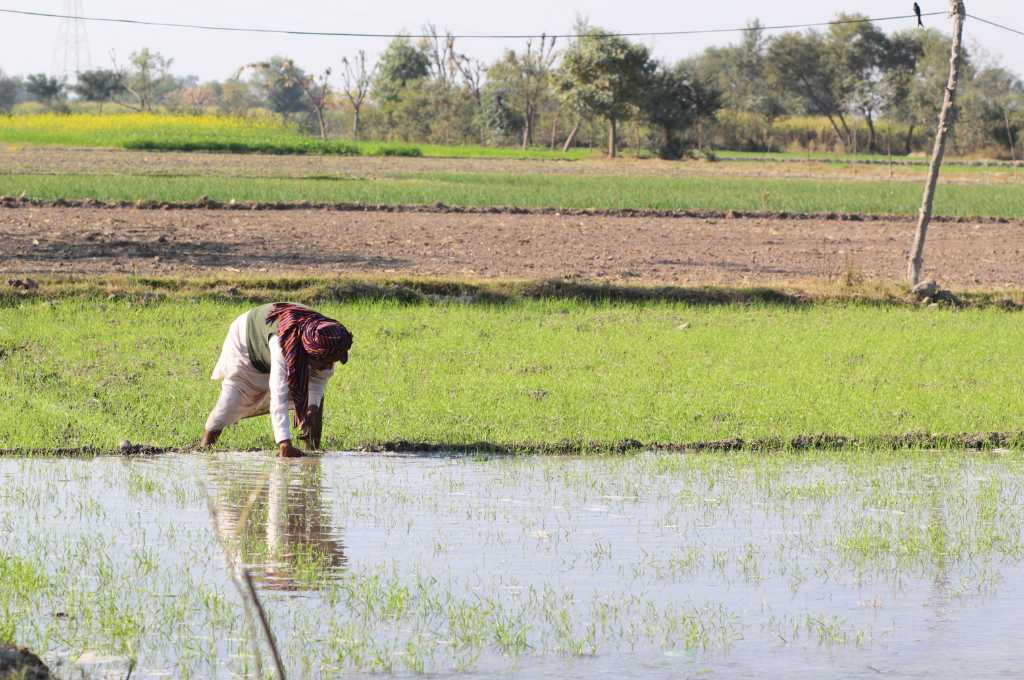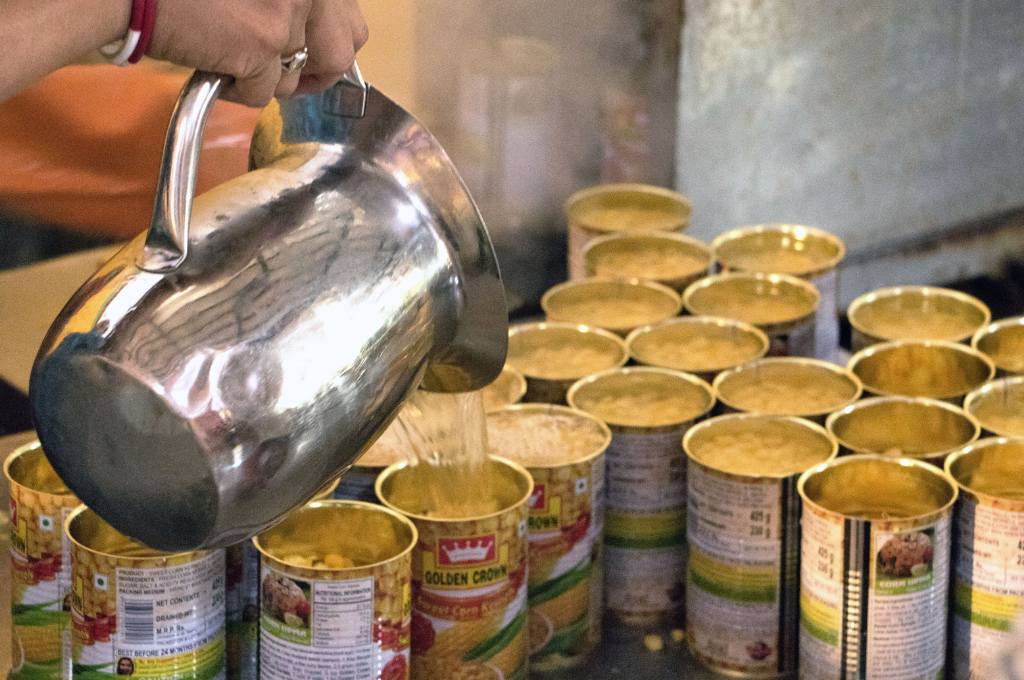There is a predictability to the narrative around North India’s air pollution. Air that is unhealthy all year-round becomes unbreathable during winter, largely due to particulate matter in emissions from farm fires in Punjab, Haryana, and Western Uttar Pradesh. This contributes to the portrayal of farmers as the primary architects of Delhi’s air pollution crisis, and short-term solutions sustain only till the skies clear up.
There is no denying that the effects of seasonal paddy stubble burning are severe—it causes an estimated loss of 150,000 years of healthy life annually. Underlying stubble burning, however, is a paddy-wheat cropping system with wide-ranging effects on the region. The dominant practice of growing paddy in the kharif (monsoon) season and wheat in the rabi (winter) season, doesn’t only cause stubble burning. It has also caused Northwest India’s farm incomes to stagnate and indebtedness to increase, polluted its environment, drained its groundwater, degraded its soil, and made it vulnerable to climate change.
Thus far, solutions supported by philanthropy have treated stubble burning as an isolated issue, focusing primarily on mechanised stubble management interventions. Instead, donors and implementing nonprofits should address it as a part of Northwest India’s agricultural system, which is in need of repair.
Five key impacts of the paddy-wheat monoculture
While paddy and wheat blanket agricultural land across Punjab and Haryana, they were not always so widespread. India’s persistent food shortages in the early post-independence period were addressed by the Green Revolution—a package of interventions focussed on increasing yields of rice and wheat. This involved introducing investments in irrigation, research into high-yielding crop varieties, subsidised chemical inputs such as fertilisers, and machinery, particularly in Punjab, Haryana, and Western Uttar Pradesh. All of which led to a dramatic increase in the yield of, and area under, wheat and paddy, and quickly replaced the traditionally diverse mix of local crops.

However, despite significant changes to the environment and the economy since the 1960s, the policy environment continues to favour the paddy-wheat monoculture system. A range of negative externalities have emerged and grown over time, most importantly including groundwater depletion, stubble burning, soil and water degradation, economic stagnation, and climate change vulnerability.
- Groundwater depletion: A key Green Revolution intervention was the introduction of new varieties of paddy which gave high yields under intensive flood irrigation—a technique that uses huge amounts of water. In semi-arid Northwest India, groundwater reserves supply the bulk of this water. Free electricity to pump wells provided to farmers in Punjab and Haryana, has exacerbated the usage of groundwater, leading to its depletion. It is estimated that there will be severe shortage of groundwater not only for irrigation, but also for drinking in 15-20 years. Alternative cereal crops such as millets can reduce water use without affecting total land use or calorie production.
- Stubble burning: Before the sowing of wheat—which typically happens in November—farmers have to clear the large quantities of residue produced at the time of harvesting paddy. Furthermore, because groundwater levels have depleted considerably over time, farmers in Punjab and Haryana delay paddy planting and harvesting until the monsoons; which increases the pressure to quickly clear their fields by burning stubble.
- Soil and water degradation: Each cycle of paddy and wheat cultivation removes nutrients from the soil, as key elements like carbon, nitrates, phosphates, and potassium, are taken up into the plant during growth and removed from the ecosystem when the plant is harvested. This causes a continuous degradation of soil health and a decline in land productivity. In response, farmers must continually apply increasing amounts of fertiliser, in order to maintain constant yields. The high yields of the paddy-wheat monoculture cycle are maintained with vast amounts of synthetic fertilisers and pesticides, which seep into groundwater and run off into canals. The resulting accumulation of toxins in the drinking water supply has been linked to high cancer rates in the region.
- Economic stagnation: Across Northwest India, and particularly in Punjab, agricultural GDP is growing far more slowly than in other states in India. The rewards of growing paddy and wheat have hit a point of diminishing returns, in terms of both agricultural and economic productivity. Meanwhile, the rising cost of cultivation, including prices of fertilisers, pesticides, and other inputs, has led to high levels of debt and lower profitability for farmers. Diversifying into high-value crops can be a key strategy in increasing farmer incomes.
- Climate change vulnerability: Greenhouse gas emissions are projected to raise global temperatures in the coming years, with significant consequences for agriculture. India’s monsoon is likely to be disrupted, and yields of rice and wheat in Punjab are likely to fall substantially with temperature and rainfall changes. Monocultured cropping patterns such as paddy-wheat are especially vulnerable to climate change, and a diversified farm is a key part of climate-resilient agricultural practice. As a bonus, modifying the paddy-wheat cycle can significantly increase the carbon sequestration ability of soils, mitigating climate change while reducing water usage.
Five ways philanthropy can chip in
A comprehensive and holistic approach to agricultural transformation is the only sustainable way to avoid unintended consequences. Further, any intervention should take the route of offering farmers tools and incentives, and providing information, rather than coercing them to follow instructions.
Due to the large role of the government in all aspects of agriculture—from subsidies, infrastructure investment, Public Distribution System (PDS) management, and environmental regulation—any action at scale must come from the state. The role of philanthropy and the development sector, then, should be to demonstrate working scalable models of alternative agricultural practice, and generate the evidence for changes in agricultural policy.
1. Subsidy reform pilots
The central government has thus far been funding the procurement of nearly all the wheat and rice produced in Punjab and Haryana, at a relatively high Minimum Support Price (MSP). In addition, the two state governments provide free electricity to all farmers for pumping groundwater, leading to huge fiscal outlays as well as incentivising cultivation of water-intensive paddy. These policies, as well as other subsidies (such as on fertilisers), provide indirect income support to farmers, but incentivise paddy-wheat monoculture. By piloting and evaluating alternate models of farmer income support (such as direct subsidy transfers to farmer bank accounts), philanthropy may make it possible to reduce this misaligned incentive, without hurting farmers economically.
For example, the ‘Pani Bachao Paisa Kamao’ project demonstrates the potential of replacing free electricity with a direct benefit transfer for the value of electricity saved. This offers farmers the same monetary value as the subsidy, while also giving them the flexibility to make money by reducing their pumping electricity consumption. This directly incentivises farmers to reduce their water consumption, and can make less water-intensive crops more attractive.

2. Strengthening farmer collectives
The decades-long focus on paddy and wheat cultivation has restricted the knowledge base, physical infrastructure, availability of inputs, and post-harvest support available to farmers, to these two crops. Making this support available to farmers for alternate crops on an individual level is likely to be expensive and challenging.
Alternatively, Farmer Producer Organisations (FPOs) can be vehicles for making alternative crops viable at a small scale.
Alternatively, Farmer Producer Organisations (FPOs)—collectives formed and run by farmers to aggregate and procure crops from members and sell it to the government or market—can be vehicles for making alternative crops viable at a small scale. This is achievable by collectively investing in the knowledge, inputs, and physical infrastructure required to grow paddy replacements or perform diversified farming activities. For example, an FPO could invest in shared machinery suitable for horticulture, maize-drying units, or oilseed pressing facilities, and make those crops more profitable choices for its member farmers.
Philanthropy can directly support FPOs until they become self-sustaining, like the Tata Trusts have done for dairying FPOs, and successful examples can serve as models for others across the region.
3. Piloting value chain linkage model
Individual farmers as well as FPOs in Punjab and Haryana lack successful alternative models of market-linked agricultural production to emulate. With or without modifications to the prevailing subsidy regime, demonstrating profitable alternate models can incentivise and accelerate diversification. Philanthropy can invest in establishing exemplar value chains, from scientific input availability to storage, transport, processing, and marketing of alternate crops, demonstrating that production of such crops can be remunerative.
4. Updating agricultural institutions
Northwest India’s agricultural universities and institutions, such as Punjab Agricultural University (PAU) and the Indian Agricultural Research Institute (IARI), were a critical part of the Green Revolution. They educated scientists, supported agronomy research, and provided extension services to farmers. Now, their activities remain largely focused on increasing production of paddy and wheat.
Supporting these institutions in updating their goals, work areas, and methods, could be a promising intervention that the development sector is well placed to undertake, with easier access to international knowledge hubs. Funding for research grants or capacity building in areas such as conservation agriculture, climate-resilient agriculture, and crop diversification, could catalyse significant changes in prevailing cropping practice.
5. Productivity enhancement in Eastern India
Public procurement of paddy and wheat from Northwest India forms a significant fraction of the food grain supply for India’s Public Distribution System (PDS). A majority of Indians depend on the PDS for their basic caloric requirements, so a reduction in paddy or wheat procurement from Punjab and Haryana would require a compensating increase in procurement elsewhere.
Paddy, in particular, is a prime candidate for movement to the water-rich states of Eastern India, which are climatically more suited to growing paddy than the semi-arid Northwest. These states have low yields of paddy at present, and need significant investments in locally suitable high-yielding varieties, physical infrastructure such as rural roads and market yards, irrigation facilities, access to credit, and appropriate inputs. Philanthropy can provide some investments directly, through microcredit and agronomy research grants, while supporting the state in providing other investments.
—
Know more
- Learn about the idea of a Second Green Revolution.
- Understand how climate change will impact Indian agriculture.





